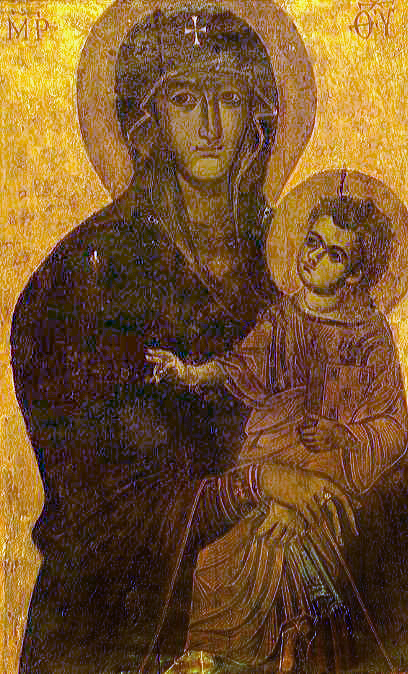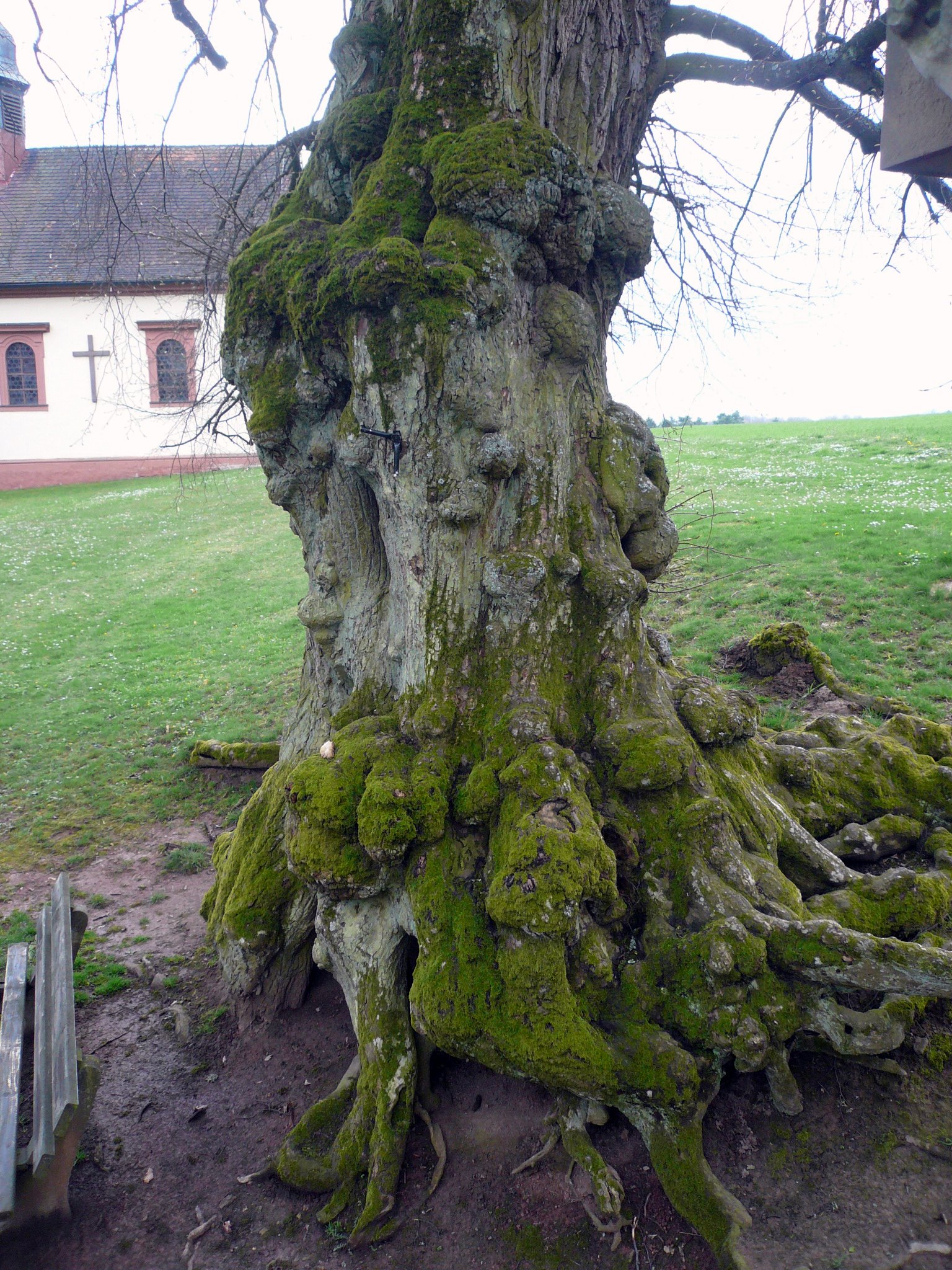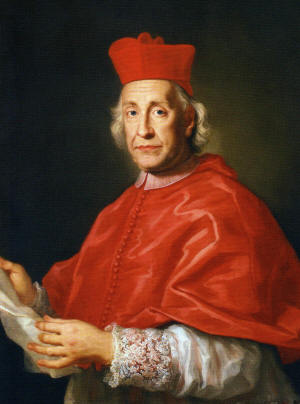|
Virgin Kębelska
The Virgin of Kębło () is a medieval sculpture of the Madonna and Child, located in the shrine in Wąwolnica. The statue was brought to Wąwolnica from the nearby village of Kębło, hence its name. Figurine The Gothic sculpture of the Madonna and Child dates from the first half of the fifteenth century (around 1420 to 1440). It was made from a trunk of the lime tree with a height of 85 cm and a diameter at its widest point 27 cm. Its prototype was a stone statue of the Madonna from Vimperk. This style of sculpture is characterized by elegance and courtliness in presenting subtly, drawing a regular face and the richness and decorative draperies into the system. The mother figure is shown presenting the child Jesus to the world. History of veneration The tradition of the veneration of Our Lady of Kębło and Wąwolnica probably dates back to the period of invasions by the Tatars at the end of the 13th century. According to parish records, in the first days of ... [...More Info...] [...Related Items...] OR: [Wikipedia] [Google] [Baidu] |
Madonna (art)
In Christian art, a Madonna () is a religious depiction of the Blessed Virgin Mary in a singular form or sometimes accompanied by the Child Jesus. These images are central icons for both the Roman Catholic and Eastern Orthodox Church, Orthodox churches. The word is (archaic). The Madonna and Child type is very prevalent in Christian iconography, divided into many traditional subtypes especially in Eastern Orthodox iconography, often known after the location of a notable icon of the type, such as the ''Theotokos of Vladimir'', ''Agiosoritissa'', ''Blachernitissa'', etc., or descriptive of the depicted posture, as in ''Hodegetria'', ''Eleusa icon, Eleusa'', etc. The term ''Madonna'' in the sense of "picture or statue of the Virgin Mary" enters English usage in the 17th century, primarily in reference to works of the Italian Renaissance. In an Eastern Orthodox context, such images are typically known as ''Theotokos''. "Madonna" may be generally used of representations of Mar ... [...More Info...] [...Related Items...] OR: [Wikipedia] [Google] [Baidu] |
Wąwolnica, Lublin Voivodeship
Wąwolnica is a town in Puławy County, Lublin Voivodeship, in eastern Poland. It is the seat of the gmina (administrative district) called Gmina Wąwolnica. It lies approximately south-east of Puławy and west of the regional capital Lublin. Legendary origins According to legend, around the seventh century AD (some sources mention that it was probably 721) Krakus, Prince Krak came from Kraków. Visiting the area, he found the site of the current Wąwolnica, which he named Wąwelnica - from the name of his home (Wawel). The coat of arms of the town shows St. George (Prince Krak was believed to have slain the Wawel Dragon). History Wąwolnica is one of the oldest settlements in Lesser Poland (initially as part of the Sandomierz Voivodeship, and later in the Lublin Voivodeship (1474–1795), Lublin Voivodeship in the Lesser Poland Province, Crown of the Kingdom of Poland, Lesser Poland Province). Together with Bochotnica it formed the heart of the local administrative unit. A m ... [...More Info...] [...Related Items...] OR: [Wikipedia] [Google] [Baidu] |
Kębło
Kębło is a village in the administrative district of Gmina Wąwolnica, within Puławy County, Lublin Voivodeship Lublin Voivodeship ( ) is a Voivodeships of Poland, voivodeship (province) of Poland, located in the southeastern part of the country, with its capital being the city of Lublin. The region is named after its largest city and regional capital, Lu ..., in eastern Poland. See also * Virgin Kębelska References Villages in Puławy County {{Puławy-geo-stub ... [...More Info...] [...Related Items...] OR: [Wikipedia] [Google] [Baidu] |
Tilia
''Tilia'' is a genus of about 30 species of trees or bushes, native throughout most of the temperateness, temperate Northern Hemisphere. The tree is known as linden for the European species, and basswood for North American species. In Great Britain and Ireland they are commonly called lime trees, although they are not related to the citrus Lime (fruit), lime. The genus occurs in Europe and eastern North America, but the greatest species diversity is found in Asia. Under the Cronquist system, Cronquist classification system, this genus was placed in the family Tiliaceae, but genetic research summarised by the Angiosperm Phylogeny Group has resulted in the incorporation of this genus, and of most of the previous family, into the Malvaceae. ''Tilia'' is the only known ectomycorrhizal genus in the family Malvaceae. Studies of ectomycorrhizal relations of ''Tilia'' species indicate a wide range of fungal symbionts and a preference toward Ascomycota fungal partners. Description ''T ... [...More Info...] [...Related Items...] OR: [Wikipedia] [Google] [Baidu] |
Vimperk
Vimperk (; ) is a town in Prachatice District in the South Bohemian Region of the Czech Republic. It has about 7,300 inhabitants. The historic town centre is well preserved and is protected as an urban monument zone. Historically Vimperk has been known as an important regional trade centre, being located on the Golden Trail from Passau to Prachatice. Vimperk is also renowned for its glass-making and printing traditions. Administrative division Vimperk consists of 22 municipal parts (in brackets population according to the 2021 census): *Vimperk I (504) *Vimperk II (5,460) *Vimperk III (375) *Arnoštka (6) *Bořanovice (72) *Boubská (101) *Cejsice (18) *Hrabice (124) *Klášterec (32) *Korkusova Huť (35) *Křesanov (37) *Lipka (83) *Michlova Huť (12) *Modlenice (3) *Pravětín (85) *Skláře (23) *Solná Lhota (14) *Sudslavice (35) *U Sloupů (84) *Veselka (8) *Vnarovy (14) *Výškovice (60) Geography Vimperk is located about south of Prachatice and west of České Budějo ... [...More Info...] [...Related Items...] OR: [Wikipedia] [Google] [Baidu] |
Tatars
Tatars ( )Tatar in the Collins English Dictionary are a group of Turkic peoples across Eastern Europe and Northern Asia who bear the name "Tatar (term), Tatar". Initially, the ethnonym ''Tatar'' possibly referred to the Tatar confederation. That confederation was eventually incorporated into the Mongol Empire when Genghis Khan unified the various steppe tribes. Historically, the term ''Tatars'' (or ''Tartars'') was Endonym and exonym, applied to anyone originating from the vast North Asia, Northern and Central Asian landmass then known as Tartary, a term which was also conflated with the Mongol Empire itself. More recently, however, the term has come to refer more narrowly to related ethnic groups who refer to themselves as ''Tatars'' or who speak languages that are commonly referr ... [...More Info...] [...Related Items...] OR: [Wikipedia] [Google] [Baidu] |
Order Of Saint Benedict
The Benedictines, officially the Order of Saint Benedict (, abbreviated as O.S.B. or OSB), are a mainly contemplative monastic order of the Catholic Church for men and for women who follow the Rule of Saint Benedict. Initiated in 529, they are the oldest of all the religious orders in the Latin Church. The male religious are also sometimes called the Black Monks, especially in English speaking countries, after the colour of their habits, although some, like the Olivetans, wear white. They were founded by Benedict of Nursia, a 6th-century Italian monk who laid the foundations of Benedictine monasticism through the formulation of his Rule. Benedict's sister, Scholastica, possibly his twin, also became a religious from an early age, but chose to live as a hermit. They retained a close relationship until her death. Despite being called an order, the Benedictines do not operate under a single hierarchy. They are instead organized as a collection of autonomous monasteries a ... [...More Info...] [...Related Items...] OR: [Wikipedia] [Google] [Baidu] |
Łysa Góra
Łysa Góra , translated as Bald Mountain, is a well-known hill in Świętokrzyskie Mountains, Poland. With a height of 595 metres (1,952 ft), it is the second highest point in that range (after Łysica at 612 meters or 2,008 ft). On its slopes and atop its summit are several hiking trails, the ruins of a pagan wall from 9th century, the Benedictine monastery from the 11th century, and the Święty Krzyż TV Tower. The mountain also features prominently in a Lysa Hora (folklore), local legend about witches' sabbath (witchcraft), sabbaths. Names Former or corresponding names of the site include Łysica and Święty Krzyż. Location Łysa Góra, composed primarily of quartzite and Cambrian slates, lies in the eastern part of the Łysogóry range, and is the second largest peak of the larger Świętokrzyskie Mountains (after Łysica). A notable summit within the Świętokrzyski National Park, it is a vital point in many sightseeing trails of the region. The blue path to P ... [...More Info...] [...Related Items...] OR: [Wikipedia] [Google] [Baidu] |
Pope Clement XII
Pope Clement XII (; ; 7 April 16526 February 1740), born Lorenzo Corsini, was head of the Catholic Church and ruler of the Papal States from 12 July 1730 to his death in February 1740. Clement presided over the growth of a surplus in the papal finances. He thus became known for building the new façade of the Basilica of Saint John Lateran, beginning construction of the Trevi Fountain, and the purchase of Cardinal Alessandro Albani's collection of antiquities for the papal gallery. In his 1738 bull , he provides the first public papal condemnation of Freemasonry. Early life Lorenzo Corsini was born in Florence in 1652 as the son of Bartolomeo Corsini, Marquis of Casigliano, and Elisabetta Strozzi, the sister of the Duke of Bagnuolo. Both of his parents belonged to the old Florentine nobility. He was a nephew of Cardinal Neri Corsini and was a distant relative of Saint Andrew Corsini. Corsini studied at the Jesuit Roman College in Rome and also at the University of Pi ... [...More Info...] [...Related Items...] OR: [Wikipedia] [Google] [Baidu] |
Chancel
In church architecture, the chancel is the space around the altar, including the Choir (architecture), choir and the sanctuary (sometimes called the presbytery), at the liturgical east end of a traditional Christian church building. It may terminate in an apse. Overview The chancel is generally the area used by the clergy and choir during worship, while the congregation is in the nave. Direct access may be provided by a priest's door, usually on the south side of the church. This is one definition, sometimes called the "strict" one; in practice in churches where the eastern end contains other elements such as an ambulatory and side chapels, these are also often counted as part of the chancel, especially when discussing architecture. In smaller churches, where the altar is backed by the outside east wall and there is no distinct choir, the chancel and sanctuary may be the same area. In churches with a retroquire area behind the altar, this may only be included in the broader defi ... [...More Info...] [...Related Items...] OR: [Wikipedia] [Google] [Baidu] |
Pope Paul VI
Pope Paul VI (born Giovanni Battista Enrico Antonio Maria Montini; 26 September 18976 August 1978) was head of the Catholic Church and sovereign of the Vatican City State from 21 June 1963 until his death on 6 August 1978. Succeeding John XXIII, he continued the Second Vatican Council, which he closed in 1965, implementing its numerous reforms. He fostered improved ecumenical relations with Eastern Orthodox and Protestant churches, which resulted in many historic meetings and agreements. In January 1964, List of pastoral visits of Pope Paul VI, he flew to Jordan, the first time a reigning pontiff had left Italy in more than a century. Montini served in the Holy See's Secretariat of State from 1922 to 1954, and along with Domenico Tardini was considered the closest and most influential advisor of Pope Pius XII. In 1954, Pius named Montini Archbishop of Milan, the largest Italian diocese. Montini later became the Secretary of the Episcopal Conference of Italy, Italian Bishops' Co ... [...More Info...] [...Related Items...] OR: [Wikipedia] [Google] [Baidu] |






